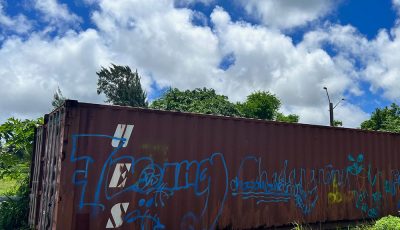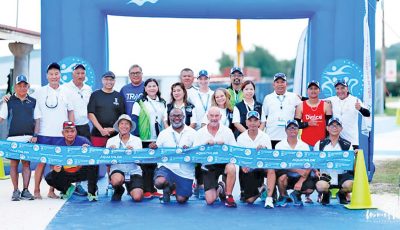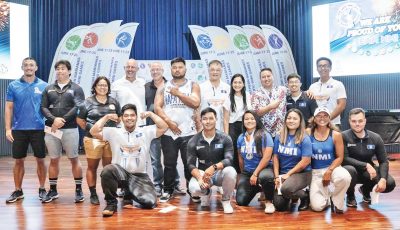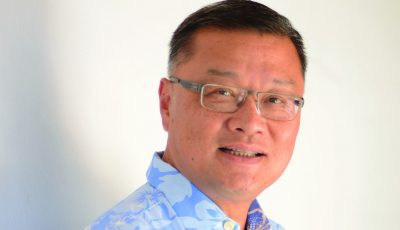Oleai Sports Complex facelift after Mini Games
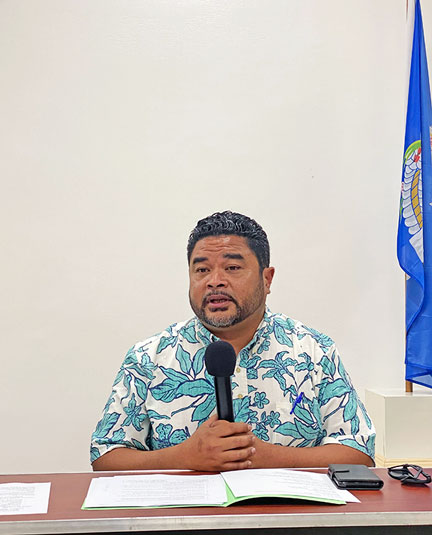
Office of Planning and Development director Kodep Ogumoro-Uludong speaks on the scope of work of the CNMI Sports and Cultural Tourism Enhancement project that would revamp the Oleai Sports Complex. (Kimberly B. Esmores)
Hold your horses. The revamping of the Oleai Sports Complex will not commence until after the Pacific Mini Games scheduled for 2022.
In an interview with Robert Hunter, former Department of Community and Cultural Affairs secretary who had a hand in the application for the $21.2-million grant recently approved by the Economic Development Administration of the U.S. Department of Commerce, he said the project may not start until after the upcoming Mini Games.
“The CNMI Sports and Cultural Tourism Enhancement project that will oversee the complete rehabilitation of the Oleai Sports Complex isn’t going to be done in time for the Mini Games,” he said.
The now senior policy advisor to Gov. Ralph DLG Torres explained that originally, everyone involved wanted to complete the Oleai Sports Complex first. However, that was over a year ago, now, with the Mini Games fast approaching, the facilities must be game-ready, not under construction.
“Now we’re a year out from the Games so there’s no way this is going to get done in time for the Games and I don’t think we want to rush this. We want to make this the best place for the long term. We can’t be in the middle of construction during the Mini Games. This needs to be a usable facility,” he said.
The plan, although it is still under discussion, could be to go ahead with the cultural events center construction first and the sports complex after.
“This could be the case where we start on the cultural events site and then focus on this after the Games. I hate to say that but that might be the reality. Guam has their own site, but it’s not going to come close to what this is designed to be. We want this to be a premiere site in Micronesia and to be one of the most, if not the most, advanced sports complex in the entire Micronesia region,” he said.
Office of Planning and Development director Kodep Ogumoro-Uludong said the goal is to make this project the “crown jewel” of the CNMI.
“This is certainly going to be a crown jewel upon completion and we’re just very excited to be a part of this. This was really a huge community effort with a lot of community stakeholders and again, with the direction and support of Gov. Ralph DLG Torres and Lt. Gov. Arnold I. Palacios, we were able to prioritize this application over many others. We give much credit to EDA engineer Mariano Iglecias and Stan Good, we had a great team that was really involved in different stages of the proposal,” he said.
According to Ogumoro-Uludong, the scope of work for the sports complex includes renovation and rehabilitation to the existing Gilbert C. Ada Gymnasium to repair damage, enhance storm resiliency, and improve the building. Construction will include roofing resistant to 190 miles per hour winds and a second-floor addition for office space and conference rooms.
Additionally, separate concrete storage facility (approximately 10 ft. x 20 ft.) to be associated with the gym and track will also be constructed.
The scope of work also includes the construction of an Olympic-size swimming pool with associated facilities such as a cantilevered roof, electronic timers, pumps, piping, water storage, spectator bleachers, locker rooms, and utility rooms.
Two International Tennis Federation tennis courts with associated facilities such as warm-up walls, fencing, and bleachers are also included in the project.
Lastly, the project will cover the rehabilitation and renovation of the baseball stadium and associated facilities including addition of spectator grandstand, lighting, announcer box, batting cages, dugouts, and concession stand.
Meanwhile, for the Cultural Events Center Park Components, the project will cover the construction of a cultural center “Main House Pavilion” (approximately 30 feet x 50 feet or 1,500 square feet), the construction of up to nine moderate-size kiosks (approximately 720 square feet each), the construction of up to 44 small kiosks (approximately 162 square feet each), the construction of an amphitheater stage with associate facilities such as rear storage area, dressing rooms. and the construction of new paved parking areas.
Repairs and renovations will also be made to the Guma Sakman Building to be used as a training and exhibition center and also for administrative offices, and an addition of up to three restroom facilities.
The project will also cover landscaping and general outdoor improvements which may include lighting, sidewalks, and benches.
An Americans with Disabilities Act compliant Pedestrian overpass with at least 16-foot high underpass traffic clearance will also be completed as part of the project.
Lastly, needed utilities and infrastructure identified in the application to support the construction, repairs, and renovations will also be covered by the EDA funding.



